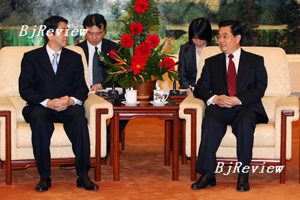|

China-Japan relations have gone through two stages in 2006. In the first nine months of this year, as Junichiro Koizumi was finishing his term as Japanese prime minister, bilateral relations hit a historical low point since they were normalized in 1972. However, as Shinzo Abe took the reins of government, a new page in relations was opened, as evidenced by his "ice-breaking" tour of China 13 days after he assumed office. In a nutshell, the relationship between China and Japan took a turn for the better after going through twists and turns.
Plummeting relations
China-Japan relations were chilly during Koizumi's last nine months in office. Politically, bilateral exchanges of high-level visits were suspended. After Chinese Vice Premier Wu Yi visited Japan in May 2005, no other high-ranking officials stepped on the soil of each other's country. Even on multilateral occasions, the leaders of the two countries did not hold any meaningful meetings.
On the security front, distrust between the two countries deepened. Japan repeatedly touted "China threat" rhetoric. It held a joint military drill with the United States near the disputed oil and gas fields in the East China Sea in February this year, a move that was clearly directed at China. On August 1, it published the Defense of Japan 2006 white paper, exaggerating "China's military threat."
Economic cooperation between China and Japan slowed down. From January to September this year, China received $3.27 billion worth of direct investment from Japan, down 30 percent from the same period of the previous year. The bilateral trade volume from January to October stood at $168.5 billion, far lower than that between China and the United States, which was $214.5 billion, and that between China and the EU, which was $218.9 billion. The figures provide evidence that economic relations between China and Japan, which have been close, were greatly dampened in the wake of the political standoff.
The tipping point
However, bilateral relations took a turn for the better when Abe took office on September 26 and visited China shortly after that. First, the door to top-level dialogue was opened. Abe was received by Chinese President Hu Jintao and other leaders during his visit on October 8. On November 18, Abe and Hu met again in Hanoi, Viet Nam on the sidelines of the summit of the Asia-Pacific Economic Cooperation forum. The two meetings held in the space of about one month spoke of the shared will of China and Japan to improve bilateral relations.
Second, the areas for bilateral dialogue and cooperation were reaffirmed. The leaders expressed a common intention for future cooperation and exchanges during their meetings.
On the economic front, the governments of the two countries will facilitate ministerial meetings and consultations between departments as well as non-governmental dialogues. They are committed to increasing bilateral economic cooperation and exploring the possibility of creating a free trade area between the two countries.
On the issue of the East China Sea, the two countries pledged to speed up consultation, stick to the principle of jointly developing the oil and gas resources in the sea and seek commonly acceptable solutions.
| 